| کد مقاله | کد نشریه | سال انتشار | مقاله انگلیسی | نسخه تمام متن |
|---|---|---|---|---|
| 9435119 | 1298549 | 2005 | 28 صفحه PDF | دانلود رایگان |
عنوان انگلیسی مقاله ISI
Antiepileptic popular ketogenic diet: emerging twists in an ancient story
دانلود مقاله + سفارش ترجمه
دانلود مقاله ISI انگلیسی
رایگان برای ایرانیان
کلمات کلیدی
P domainTWIKVLCDCREBPSREBPCPT IHSP 70TFPTREKNBFcACTFKHRKirPKCTRAAKTHIKpKaCCKCRHCPT IIPPARNPYCOXFFAHCO3− - HCO3-MAPK - MAPKcyclooxygenase - آنزیم سیکلواکسیژنازArachidonic acid - اسید آراشیدونیکPolyunsaturated fatty acids - اسید چرب اشباع نشدهPUFA - اسید چرب چند غیراشباعKetone bodies - بدن کتونsur - برBicarbonate - بی کربنات، هیدروژن کربناتKetogenic diet - رژیم غذایی کتوژنیکSiD - سی دیtalk - صحبتphosphoenolpyruvate carboxykinase - فسفوآنولپیرود کربوکسیکینازnucleotide binding fold - نوکلئوتید اتصال برابر استcorticotropin releasing hormone - هورمون آزاد کننده کورتیکوتروپینTask - وظیفهsterol regulatory element binding protein - پروتئین اتصال دهنده عصاره استرولcyclic AMP responsive element binding protein - پروتئین اتصال دهنده عنصر پاسخ دهنده AMP cyclicTrifunctional protein - پروتئین سه پروتئینheat shock protein 70 - پروتئین شوک حرارت 70protein kinase A - پروتئین کیناز AProtein kinase C - پروتئین کیناز سیmitogen activated protein kinase - پروتئین کیناز فعال Mitogen فعال استProton - پروتونATP-sensitive K+ channels - کانال های K + حساس به ATPsulfonylurea receptor - گیرنده سولفونیل اورهperoxisome proliferator-activated receptor - گیرنده فعال فعال پروکسیومNeuropeptide Y - یوروپروتئین Y
موضوعات مرتبط
علوم زیستی و بیوفناوری
علم عصب شناسی
علوم اعصاب (عمومی)
پیش نمایش صفحه اول مقاله

چکیده انگلیسی
The antiepileptic activity associated with ketogenic diets (KD) have been known for some time. First reports date back to the Middle Ages and even Biblical times where KD was achieved by fasting (i.e. “water diet”) [see Swink, T.D., Vining, E.P.G., Freeman, J.M., 1997. The ketogenic diet: 1997. Adv. Pediatr. 44, 297-329, and references therein]. In the early 20th century, changes in the design of the KD were introduced, shifting the so-called “water diet” to a high-fat diet. Initial clinical evaluations undertaken between the 1920s and 1940s were enthusiastic, but the popularity of the KD was retrograded upon clinical introduction of phenytoin and subsequently other antiepileptic drugs. Today, despite a pharmacological arsenal targeting cerebral receptors and specific events in seizure initiation and development, about 30-40% patients are still refractory to available medications. Thus, the KD has been re-introduced in recent years as an alternative therapy, averring to be efficacious against some instances of resistant or intractable epilepsy. Despite a long historical background and enlarged clinical use, identification of the underlying anticonvulsant mechanisms associated with this nonpharmacological approach is still in stagnation. The present review is an attempt to encourage current research orientation through well-based and directed proposals for putative emerging candidates mediating KD anticonvulsant mechanisms. The reader is provided with a special emphasis on ATP-sensitive and recently cloned two-pore (or tandem) domain potassium channels, as well as several emerging conceptual views and advances such as nuclear receptors, uncoupling proteins and gap junctions that the authors speculate may contribute to understanding the basic mechanisms linked to the KD.
ناشر
Database: Elsevier - ScienceDirect (ساینس دایرکت)
Journal: Progress in Neurobiology - Volume 75, Issue 1, January 2005, Pages 1-28
Journal: Progress in Neurobiology - Volume 75, Issue 1, January 2005, Pages 1-28
نویسندگان
Joseph Vamecq, Louis Vallée, Florian Lesage, Pierre Gressens, James P. Stables,